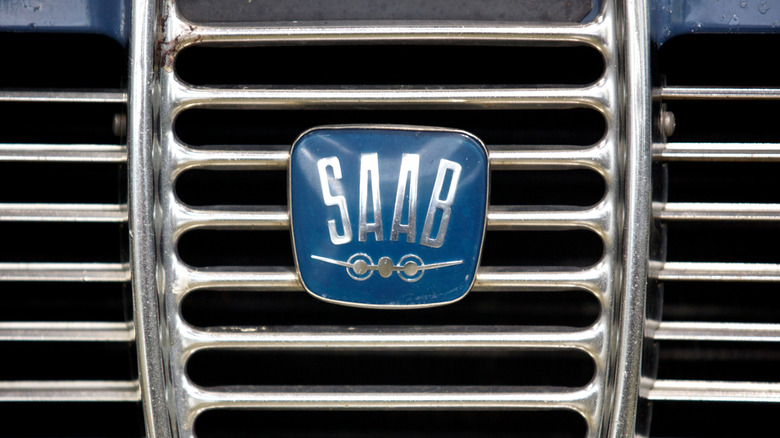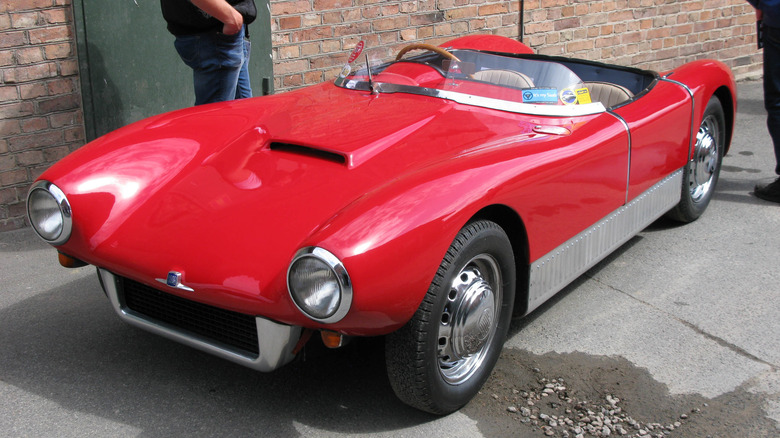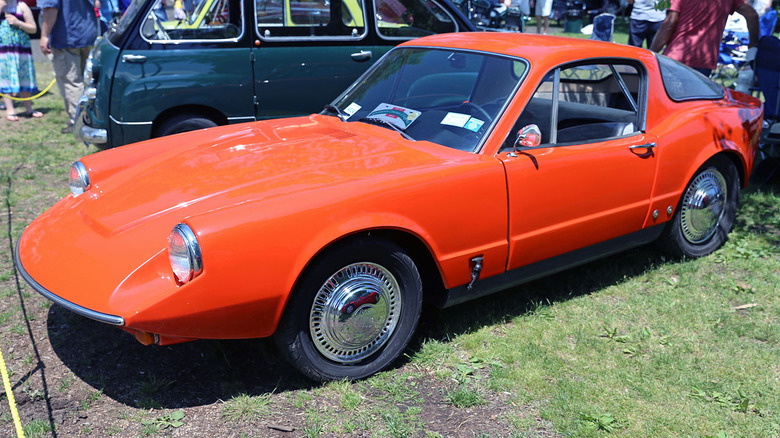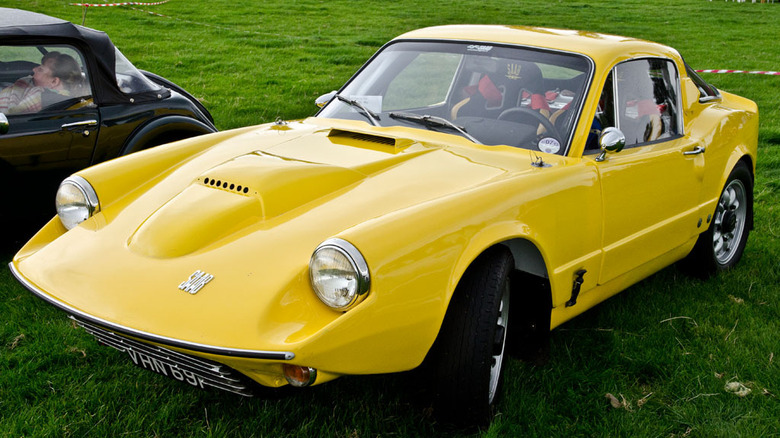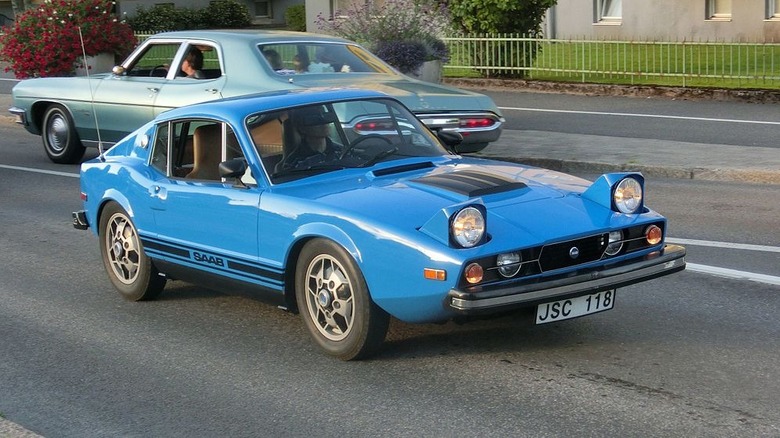Everything To Know About The Saab Sonett
Today, Saab is best known for its fighter jet, the JAS 39 Gripen, but once upon a time, they made automobiles.
Despite the similar-sounding name, Saab's Sonett is not a poem but the only "true" sports car the Swedish automobile manufacturer ever produced. Built between 1955 and 1974, the Sonett was released in three different versions, with the first (1955 – 1957) and second iterations (1966 – 1969) having a nearly decade gap between releases.
So, much like the ancient proverb about cats having nine lives, you could say this car also had multiple lives. But to properly tell the Sonett's origin story, we must first jump back to the late 1940s, when Rolf Mellde was in charge of Saab's engine development. Mellde was an auto racing fan who was able to nudge the company into the motorsports arena, where Saab cars subsequently won several races into the 1950s.
By the autumn of 1954, Mellde was intent on getting the Swedes to build a sports car. At first, Saab balked at the idea, so on his own initiative and off the company clock, he began working on a two-seat roadster. In January of '55, Mellde returned to upper management armed with a final blueprint for what he unofficially dubbed the Saab 94.
This time, he was given the green light and joined forces with Saab's in-house designer, Sixten Sason. Work began by using an assortment of different and sometimes advanced (at the time) materials that had rarely been used in the automotive world.
The Sonett I never took flight
According to Hagerty, this included a "stressed-skin aluminum platform" that only weighed 154 pounds, with metal parts riveted together to form a semi-monocoque internal framework. The rest of the components (i.e., engine, axles, fuel tank, and body) were attached directly to this sub-structure. If this sounds like an airplane fuselage design, you're not wrong.
They used "glass fiber reinforced plastic" (better known as fiberglass) to mold the exterior bodyshell, and a company with the oddly similar name of Soab built the actual shell out of plastic. Given all the lightweight materials, the Sonett's overall curb weight was just over 1,100 pounds. Thus, the 748cc three-cylinder two-stroke engine produced what might sound like a lowly 57 hp and 65 ft-lb of torque, but it was enough to give the sleek, agile car — at about 11.5 feet long and 4.5 feet wide — a top speed of 130 mph.
It was a hit when Mellde and Sason showed off the finished prototype internally. Still, the company waited to unveil it publicly until the Stockholm Motor Show the following February (1956). It continued to undergo additional testing and refinement until November (1956), when Saab signed off on five more prototypes, all of which were outsourced and completed by the following spring (1957).
Oddly, Saab gave the green light to make 2,000 Sonetts in the fall, but shortly after the new year, abruptly shifted gears and canceled the entire project. Six prototypes of the Sonett I were built, and only five still exist.
[Featured image by Herranderssvensson via Wikimedia Commons | Cropped and scaled | CC BY-SA 3.0]
The Sonett II was lackluster
A few years ticked by, and sports cars from across the pond were selling increasingly well in America. Saab dealers in the U.S. began pressuring the mothership in Sweden to make another go at the segment, even offering up their own suggestions for what a new two-seater should feature (i.e., a Targa top, crank windows instead of side screens, and road-gripping performance). They made such a convincing case that Saab caved and, in January 1963, ordered two prototypes, giving a deadline of February 1964.
One was drafted by Saab's very own Sixten Sason (of the first Sonett), and the other by Björn Karlström, who worked for Swedish aircraft manufacturer Malmo Flygindustri (MFI). Sason turned in a prototype he called the Catherina (which sits in Saab's museum in Trollhattan), while Karlström's penned plans — labeled as the MFI 13 — used a tubular frame and an 841cc two-stroke engine.
Interestingly, Saab chose Karlström's design over their own in-house designer with the (perhaps outlandish) goal of showing it off as the Saab 97 at the New York Auto Show in March 1966, which was right around the corner. So, in a few short months, three prototypes and ten pre-production models had to be built before the show opened. Not only that, but it was incumbent on Saab to provide an additional 15 pre-production cars mere weeks after the show closed.
Believe it or not, Saab unveiled the Sonett II as intended, but corners were cut.
[Featured image by Mr.choppers via Wikimedia Commons | Cropped and scaled | CC BY-SA 3.0]
The Sonett II V4 was a miserable design
The prototype's rear windows were made from plastic instead of glass, and the Targa tops weren't removable. American dealers were also shocked by the MSRP of $3,500 – $4,000 when they had previously told Saab it needed to cost less than $3,000. Doom and gloom set in almost immediately, with revised sales figures showing sales of less than 500 cars per year when original estimates pegged it at 3,000 per year.
When the production version finally rolled off the line at the end of '66, it was equipped with the 841cc Saab two-stroke three-cylinder engine taken from the Monte Carlo 850 tweaked to produce 60 hp. After lackluster sales, it switched to a 65 hp 1.5-liter Ford V4 engine (zero to 62 mph in 13 seconds, with a top speed of 106mph).
Unfortunately, that only compounded the problem because the extra 77+ pounds from the V4 made the Sonett handle like a school bus. Moreover, to facilitate the size, it added a bump to the hood, which may have looked cool as a Shaker scoop on an American muscle car but didn't come off as well on this diminutive dandy. A contemporary Road & Track review called the design "miserable" and the designer "naïve, insensitive, and unimaginative."
Only 258 of the two-stroke versions were built, selling 70 of the V4 version in 1967, another 900 the following year, and 640 in 1969. A definite sob (Saab, get it?) story, to be sure, but that didn't scare off the strong-willed Scandinavians!
[Featured image by SG2012 via Wikimedia Commons | Cropped and scaled | CC BY-SA 2.0]
Sonett's third go was a hit though, right?
Perhaps hoping the third time would be the charm, Saab rolled out the Sonett III at the New York Auto Show in 1970. This third iteration used the same chassis and — at least initially — the same engine as the Sonett II. The body was redesigned by Italian designer Sergio Coggiola, but like everything else with this car, it comes with an intriguing story.
Coggiola was told he could change the front and back but had to leave the middle alone to keep production costs down. His final version looked fantastic but wasn't realistic. For instance, the hood had such a low profile that pop-up headlights had to be used. Saab designer Gunnar Sjögren was called in to rework the plans and kept the pop-ups but forced owners to open and close them manually because including an electrical system would have been too costly.
In '71, Saab upgraded it to a more powerful 1.7 liter Ford Taunus V4. Still, it effectively had the same power output because the compression ratio was lowered to adhere to new U.S. emissions standards. Otherwise, the Sonett III didn't change much during its life cycle.
By 1974, the decision was made to give up on a total redesign as it would have been too costly, especially in light of all the new safety and emissions laws, and with 8,368 units on the road, Saab's sporty Sonett drove off into the sunset. Despite the Sonett's failure, Saab would redeem itself by making one of the most reliable turbocharged engines ever built.
[Featured image by Gunnar Creutz via Wikimedia Commons | Cropped and scaled | CC BY-SA 4.0]
